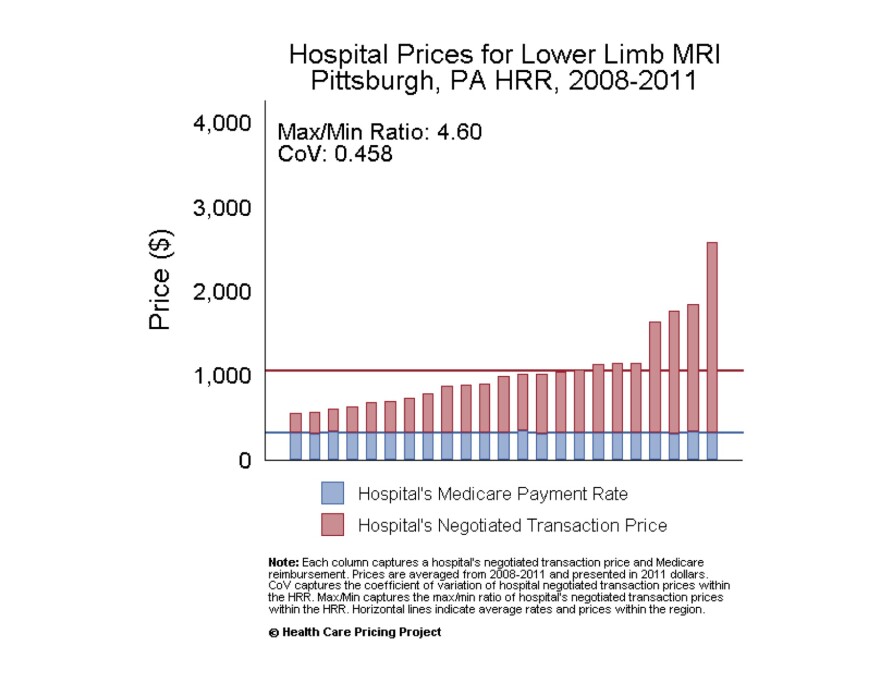If your primary care physician says you need a test or procedure, and he suggests a location to get it done, what do you do?
“There is data that shows that patients do what their doctor says,” said Mark Roberts, chair of the department of Health Policy and Management at the University of Pittsburgh Graduate School of Public Health. “When your doctor tells you, ‘I want you to see a cardiologist and I want you to see this cardiologist,’ that’s who you go see.”
Very few patients look around for the best price or the provider with the best outcomes, Roberts said. A recent study from the Health Care Pricing Project found 23 hospitals in the Pittsburgh region offer lower limb MRIs, but prices range from about $500 to more than $2,250.
“If you take your car to a garage, you get an estimate. But the idea of going into a hospital or a doctor’s office to get any procedure and have thousands upon thousands of dollars (charged), which could affect your credit, I mean, why would we accept (not knowing)?” said Cynthia Jankowski of Oakland.
Jankowski, a health care advocate, said she's tried to improve her own health care literacy, in case she ever finds herself in the stressful situation of an unfavorable diagnosis.
“If the doctor recommends a procedure, you're scared for the problem to begin with,” she said, and unknown costs add stress.

The U.S economy is based on free market capitalism and competition, but 17.5 percent of the country’s gross domestic product is tied up in health care, which is almost universally acknowledged to be anything but open or free.
“The patient doesn’t really know the quality of what they are buying, (and) the patient doesn’t know the distribution of what they are expected to need to buy in the future,” Roberts said.
The call for price transparency has grown in recent years with health care advocates, like the Pittsburgh-based Consumer Health Coalition leading the charge.
Executive Director Lou Ann Jeremko said competition and transparency were expected to improve with the initiation of the Affordable Care Act, but that has not happened. She said most consumers are only interested in knowing what their insurance deductible is and what their co-pay will be once they reach that deductible.
Roberts points to a Rand study that found people will limit the types of treatment they seek, if payments are coming out of their own pockets, but there is little data to suggest that people change behavior based on price differences among providers.
Some hospitals in the region are beginning to put prices for select procedures online, like Beaver-based Heritage Valley Health System, which lists the price of about 40 procedures. Last month, St. Clair Hospital in Mt. Lebanon rolled out a system where consumers can input insurance information, choose a service and find an approximate price, including an update on where customers stand with deductibles and specific co-pay requirements.
St. Clair CFO Rick Chesnos said the hospital began working on the website, in part because of feedback from patient focus groups. For now, they list pricing for more than 100 procedures, but those figures only include charges issued by the hospital.

“We are continuing to refine this product, to look at what other types of procedures our patients are asking us for,” Chesnos said. “We know the next step for us would be to incorporate the physician’s fees, too.”
But those are just prices for individual hospitals. Insurance providers are getting into the transparency game as well.
Stacy Byers, Highmark's director of digital marketing, said her company offers subscribers price quotes on approximately 1,600 procedures at all of the hospitals available through standard coverage. Their estimates are based on bundled pricing with a plus or minus 7 percent accuracy rate, Byers said.
“That means that for the day of that knee replacement, all of the various services that you need to have to get that replacement are part of that cost estimate,” she said.
Byers said those with high deductible plans use the service more often than those with lower deductibles, and many users employ the online tool to budget their personal health care spending, not just to find the most inexpensive option.

Providers initially pushed back, Byers said, but Highmark moved ahead.
“We’ve seen Uber disrupt taxis, we’ve seen AirBnB disrupt hospitality. There are disrupters out there in the health care space as well,” Byers said. “I think it’s important for us as an organization to bring these tools to market, but I also think it’s critical for us to start to look at what do consumers expect across the board in all of their dealings with the various companies that they do business with, and think , 'How do we get to be more customer-centric as an industry.’”
Some provider hesitancy may stem from simple ignorance because their accounting systems are inadequate to fully track the cost of a procedure, without adding expensive new activity-based systems.
“Many hospitals don’t really have any clue what various things cost them,” he said. “(How) the costs get distributed across the hospital department are sometimes very creative. They don’t really know themselves what it costs them to do an X-ray or a do a herniorrhaphy.”
The Health Care Pricing Project report found the price charged by a hospital has more to do with its market dominance than it does its actual costs or its quality, but Roberts said universally posting prices could force some movement.
“Because (providers) don’t want to be seen as the price gouger, but the down side is that (providers) also don’t want to be seen as the discount one," he said. "The hope is that it will bring prices closer together.”
Health care coverage on 90.5 WESA is made possible in part by a grant from the Jewish Healthcare Foundation.




